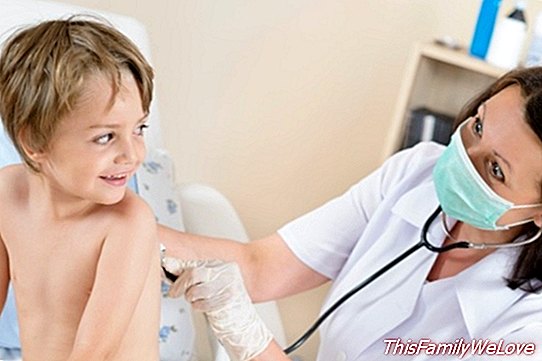Scoliosis in children: the curve of the back, symptoms and treatment

¿Scoliosis? It seems a strange name, but a lot of children should familiarize themselves with it from an early age. As a definition, scoliosis is a deflection of the column that forms a curve in which the vertebrae deviate from the central axis. We tell you everything you need to know about this deformity.
The pediatricians of the Spanish Pediatric Association (Aeped) explain that this deformity in the column "shows an asymmetric prominence (hump) to one side of the back ", something that is fully visible and can be felt when the child leans forward.
Back curves
In this sense, not all children with scoliosis have the same back: lThe curves can be thoracic, lumbar, cervical (something rarer) or even present in several areas at once.
It is also possible that double curves are given which, when developed in the opposite direction, they do not alter the verticality of the back, which would have as a consequence that its detection is later.
The causes of scoliosis
A very human reaction to any disease is to want to find the cause. However, this is not always clear. "The vast majority of the time the cause is not identified", explain the pediatricians, who indicate that in these occasions it is an "idiopathic scoliosis". There are times when scoliosis is caused by a neurological, tumor or infectious disease or is related to some syndrome, but this is much less frequent.
Scoliosis in children
Pediatricians explain that although scoliosis is similar in both sexes, girls are more at risk of progression in this disease, especially if they have more than two years to grow.
On growth, experts classify scoliosis according to the age at which it appears.
-Congénita: when children are born with malformations in the vertebrae that cause scoliosis.
- Childish: between 0 and 3 years
- Youth: between 3 and 10 years
- Teen: from 10 years old
The diagnosis of scoliosis
In general, the diagnosis of scoliosis is quite simple. "It is diagnosed with the exploration of the back ", detailed, while indicating that it is also very important to check the length of the child's legs, "palpating the two iliac crests, since the child can twist because one of the lower limbs is shorter," they indicate in this regard.
"Once it has been seen that the legs are the same, the doctor will look asymmetries between both sides of the column, looking for prominences ", summarizes, noting that what the doctor does is to check the height of the shoulders and, in some serious cases, if the trunk is tilted to the side.
Now, in addition to this exploration, there is a clinical test that gives more information: the Adams test, in which the prominences become more evident: "standing, the child leans forward without bending the knees, like to touch your feet with your hands. "
"The radiograph will confirm that there is a curve and if it associates rotation of the vertebrae, and quantify the curvature ", detail the pediatricians, who clarify that We speak of scoliosis when the angle of the curve is greater than 10 degrees.
The symptoms of scoliosis
As usual, Scoliosis has no symptoms: it does not hurt. Moreover, if scoliosis were painful, it would be necessary to think that an "infectious, neurological or even tumoral process could be behind", emphasize the pediatricians.
In this sense, it is also good to know that scoliosis does not usually have an impact on the internal organs. "Only in the very large deformities, rare on the other hand, there can be cadiopulmonary or digestive problems due to lack of space," clarify the matter, while commenting that if scoliosis is discovered at early ages and malformed vertebrae, "It is convenient to rule out associated heart, kidney or neurological injuries".
The evolution of the curve
Just as the back is not the same throughout life because the person is growing, the curve produced by scoliosis is evolving. Thus, the more there is to grow and the greater the curve at the time of diagnosis, the worse the evolution will be. "Other factors to take into account are the family history, the type of curve and if it is a girl," said the pediatricians when talking about the factors that influence the evolution of the back curve. "After the first rule, the risk of progression decreases a lot," they point out.
The treatment of scoliosis
Once scoliosis is detected, the angle of the curve and age determine which treatment should be followed. There are two main ones: the conservative (corset), that slows the progression of the deformity but does not correct it; and the surgery, that it does but it is reserved for those curves of great magnitude or that, although they are not so marked, have the risk of progressing a lot.
"The goal of the treatment is to avoid large deformities in adulthood", explain the pediatricians, who indicate that these deformities can develop if the curve reaches 50 degrees at the end of growth," so that you have to try to avoid the progression of deformities inferior to 40-45 degrees and correct with surgery those that are greater ".
In this regard, pediatricians conclude by explaining what types of corsets exist:
-Boston: The most used, should be kept around 22-23 hours a day.
-Charleston or Prividence: they are used for very flexible curves near the thorax and only at night.
Angela R. Bonachera




